|
Just over one year from its original debut on Japanese television, DragonBall Kai has made its way to American shores. It has gained a letter back in its title, it has gained a newly-produced English dub, and it comes smack in the middle of a concurrent "Dragon Box" release of the TV series its footage is based on.
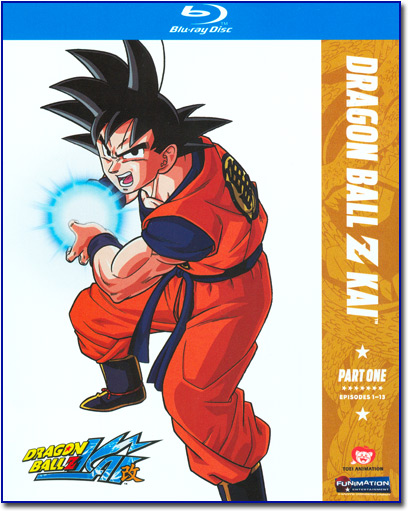
We have spoken on our podcast and forum about FUNimation's marketing of Kai — do fans actually know what it is...? While the vast majority of Daizenshuu EX readers, visitors, and listeners have it slammed into their heads ad nauseam, it is clear that the general (perhaps "casual"...?) fandom genuinely has no clue.
In a nutshell, DragonBall Kai takes the actual footage from the DragonBall Z TV series (which ran in Japan from 1989 to 1996), remasters it in high definition, and cuts out an average of half the material (generally "filler", material that was created for the sole purpose of extending the TV version in relation to the original manga). The entire original Japanese cast has returned to voice their respective characters, though a couple have been re-cast due to deaths in recent years (Hirotaka Suzuoki, Daisuke Gôri), or for any range of other inexplicable reasons. A new musical score has been provided by veteran Kenji Yamamoto, who has worked with the franchise in the form of theme song arrangements ("CHA-LA HEAD-CHA-LA", "Detekoi Tobikiri ZENKAI Pawâ!") and video game scores for decades. Newly-animated opening and ending themes surround the episodes. It airs immediately preceding One Piece on Sunday mornings in Japan (as a part of the special "Dream 9" block from 9 to 10 am), as opposed to the Wednesday evening time slot that DragonBall Z originally had. Due to this, some minor instances of what could be considered "censoring" have occurred.
For even more information on the production and release history of Kai, visit our respective "Tidbit".
For the first time ever, FUNimation's release of the "Z"-portion of the series closely mirrors its original Japanese version. It is being released uncut from the get-go. It is being released in its proper 4:3 aspect ratio both on Blu-ray and DVD, mirroring the original Japanese Blu-ray release. The English dub retains the original Japanese score (exclusively) by default for the first time since their dub of the first DragonBall TV series. The new English dub also mirrors the style of the Japanese version with the vast majority of its respective cast returning to their characters, with a few notable cast replacements (Gohan, Bulma, the narrator). Also a first for the "Z"-portion of the series, the script used (by and large) is an accurate representation of the original Japanese version.
We have spoken endlessly about Kai right here in our "Reviews" section with our look at the first Japanese Blu-ray release, in relation to the concurrent "Dragon Box" releases (volumes one and two), and especially on our weekly podcast. In the interest of a complete review, many of these opinions will be restated, though with even more familiarity with the series, as so much time has passed. In a twist, we will also be taking a close look at the English dub present on this release.
We are primarily fans of the original Japanese version of the franchise, so an in-depth look at a dub seems like a head-scratcher. Without blowing our entire load at the start of the review (and you may already know or feel this by now) — the English dub needs Kai more than the original Japanese version ever did.
ASIN: |
B0036ZA8BM (DVD)
B0036ZA8G2 (Blu-ray)
|
Publisher: |
FUNimation |
Release Date: |
18 May 2010 |
MSRP: |
$49.98 (DVD)
$54.98 (Blu-ray) |
Format: |
DVD & Blu-ray |
Contents: |
DragonBall Kai TV Episodes 1-13 |
|

Review By: Mike LaBrie (VegettoEX)
Unlike Episode #0220 of our podcast where we focused exclusively on the new English dub for the series, this written review will encompass all features of the release. This includes technical aspects, packaging, the English dub, and the fact that it is yet another release of this portion of the underlying TV series.
FUNimation's first volume of Kai covers its first 13 episodes. More than ever before, that number requires further qualification. These first 13 episodes cover what were originally the first 30 episodes of DragonBall Z (more than cutting it in half), themselves covering chapters 195 to 230 of the manga.
Long story short, it begins with Raditz arriving on Earth, and ends in the middle of Goku's fight with Vegeta.
As we covered in our review of FUNimation's first Dragon Box, this is material that North American fans have probably purchased in various incarnations several times over. It aired on television with two versions of an English dub, in Japanese, and in Spanish. The manga has been re-released multiple times. The underlying footage has been released no less than five times now. Anyone who cares knows how the story goes:
-
Prior to the start of "this series", a boy named Son Goku goes on adventures in search of seven Dragon Balls that summon a dragon to grant a wish; he fights in tournaments; he battles evil villains; he makes invaluable friends...
-
The TV series gets a new name (with a "Z" ironically re-tacked on in America)
-
Goku's alien brother Raditz shows up and explains that he is actually from the Planet Vegeta and belongs to a race called "Saiyans"; he was sent to Earth to destroy it, but a head injury as a baby changed all that
-
Goku teams up with his rival, Piccolo, to defeat Raditz, but dies in the process
-
Piccolo trains Goku's son, Gohan, for the next year while Goku trains in the afterlife under Kaiô-sama; the two remaining Saiyans are on their way to Earth to not only take the Dragon Balls for their own, but presumably kill everyone while they are at it
-
Yamcha, Chiaotzu, Tenshinhan, and Piccolo are all killed before Goku arrives
-
Vegeta, the stronger of the two Saiyans, kills his comrade Nappa after his defeat by Goku, and the two do battle!
If you are reading this particular review on this particular website, chances are that you already know all of that information and skipped down ahead. That is fine! You probably also have long-standing opinions on the content of the first batch of episodes contained within this box set and no review will change your stubborn thoughts... but in the interest of complete dissection, we will go ahead anyway.
The first part of the series had a very checkered release history in North America — for all intents and purposes, most incoming fans did not have a clue who all of these superfluous characters were, why they were all friends, and did not have any reason to care for them. The way that Kai has been released both in Japan and in North America, this is by and large no longer a problem. Kai comes after a complete home release of the entirety of the franchise in Japan, and after multiple re-releases of the entire franchise in North America. While Japan may have two decades under its belt, North America at least has a little more than a single decade to its credit. These days, fans do care about these characters, and have a vested interest in seeing them through to the end.
Unlike the story arc that will proceed it, the Saiyan arc introduces very few "new" characters:
-
Raditz: Expertly played by Shigeru Chiba in an uncharacteristically subdued performance, Raditz is little more than a plot device used to set up the new direction of the series... and his superiors. Despite his five episodes being cut down to three in Kai, any and all important scenes of Raditz remain, giving us a complete view of what little character there is. Whereas Tullece (in the third DBZ movie) would give us a more literal representation of what Goku would have become without his childhood head injury, Raditz is a first-look at the cruelty of his brethren. He is ruthless, conniving, and perhaps a little too arrogant without the guts to back it up, but he is a fun character to start things off with, none-the-less.
-
Nappa: While shifting from the original Z performance of Shôzô Îzuka to Tetsu Inada (a common side-character actor in GT), Nappa remains mostly the same — a brute, a showboat, and a (dead) lackey. He exists to simultaneously show the Earthlings just how much they are out of their league, and just how strong his superior is.
- Vegeta: Reprised by Ryô Horikawa, the Saiyan prince is calm, collected, and simultaneously anxious — he is anxious to get things resolved, he is anxious to kill anyone who gets in his way, and he in anxious to show himself up as the best there is. He is a fascinating character to watch evolve, and while we only see hints at where Toriyama will take him here in the early episodes, the seeds for a deep character have clearly been planted.
Kai is often described as "leaner and meaner" (or in FUNimation's own marketing: "faster, bigger, stronger"). Is it really, though? Does the removal of content, even that which is self-admittedly additional, sometimes extraneous, and even sometimes contrary to the original manga it is supposedly based on make for a "better" version of the show?
No. It does not.
The editing and arrangement of scenes gets better as the series goes on, but the early episodes are incredibly rough. In our review of the first Japanese Blu-ray, we noted that there was a change in editors after episode 10, and a new producer after episode 14. Shinichi Fukumitsu had been the editor on nearly all prior anime versions of the series (including many movies), so a shift in this area was somewhat unprecedented. Early episodes of Kai are frantic on a first viewing, though they do feel slightly more appropriate after repeated viewings. However, some examples are too glaringly obvious and take the viewer right out of the experience. In the very first episode, Bulma's appearance at Kame House is so heavily cut that she moves to a different area of the house within one frame:
Anyone viewing the show with anything more than a casual glance will also be taken aback by the shift between the original footage from 1989 and the redrawn/retraced footage newly done for Kai. It is clear that the animators did their best to match the visual style, but the differences in shading and texture from the original film prints is far too glaring. Some shots are definitely better than others, but anything that takes you out of the experience is a detriment to it. One of the highlights was a scene in the third episode of Kai which corrected the color of Vegeta's armor (originally shown in a brown-ish/orange-ish hue before appearing in color in the manga) to its later appearance.
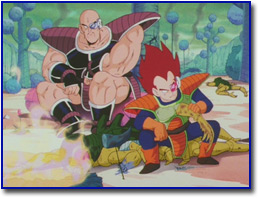 Original "Z" Scene
Original "Z" Scene |
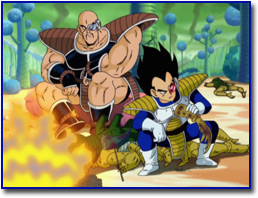 Redrawn "Kai" Scene
Redrawn "Kai" Scene |
Even when corrected to this level, the viewer will note the huge shift between original animation and the bold, newer animation. It can also create inconsistencies — despite Vegeta's armor being color-corrected, Nappa's armor (colored here similar to Raditz's) is not color-corrected to its appearance later on.
Outside of the redrawn scenes, these early episodes of DragonBall Z had some incredible animation sequences and "good animation days". There were the occasional instances of "long-neck Goku" while training with Kaiô, but when they needed to pull out all the stops, the animators settled down and got it done.
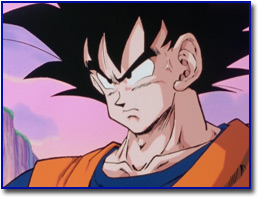 "Good Animation Day"
"Good Animation Day" |
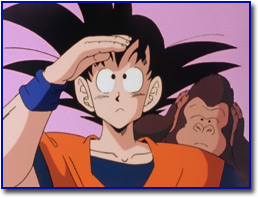 "Bad Animation Day"
"Bad Animation Day" |
We should note that any "censoring" that has occurred in the video is not of FUNimation's doing. The covering of genitalia, the hole through Goku's chest, instances of blood removal... these are all native to the original Japanese production of Kai. Chalk it up to changing Japanese broadcast standards, the switch in a time slot from evening to morning, or whatever other reason you want to put forth, but the fact remains that this is how Kai looks. FUNimation's home release (as opposed to the North American TV broadcast, which is not the subject of this review) is 100% unedited and untouched compared to its Japanese counterpart.
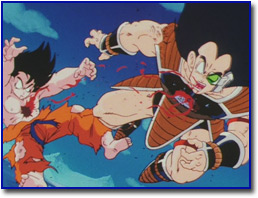 DragonBall Z
DragonBall Z |
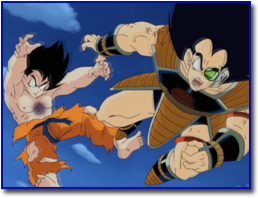 DragonBall Kai
DragonBall Kai |
It is impossible to discuss Kai without at least acknowledging the amount of material "removed" from it. Fans will remember filler episodes such as Gohan meeting his robot friend and hanging out with orphans, as well as the Z-Senshi traveling to a different reality to battle against the "Illusion Saiyans". Despite not being present in the manga, many of these scenes and episodes served an important purpose on a week-to-week basis by allowing you to spend more time with the characters and grow even more emotionally invested in them. This was of particular importance in the Saiyan arc when the majority of these characters were about to be picked off one-by-one. Is something "lost"...? Absolutely. Can (or does) it affect your enjoyment of the series as a whole? It will differ from fan to fan, but repeated viewings prove that almost everything you need for your emotional strings to be tugged is still there.
The early episodes of Kai have a leg-up on later episodes in terms of a musical score. Since this is the beginning of the series, it is difficult for tunes to be over-used — they have just been introduced! The fantastic orchestral version of "Dragon Soul" (found on the first soundtrack to the series) backs up the first episode's recap with the exact upbeat, shônen tone that it so badly deserved. "Requiem ~To Those Who Meet Their End~" will end up as one of those over-used tracks, but in its early appearances it fits the mood perfectly. Some of Yamamoto's jazzy tunes hearken back to his collaboration with Tower of Power for the DragonBall Z 2 (Budokai 2) soundtrack, while "A Battle Of Rivalry" and its blaring guitars feel out-of-place, hokey, and an unfortunate reminder of FUNimation's replaced musical score for the series all throughout the last decade.
Yamamoto's score has been adequate. It has been serviceable. It has been acceptable. Insert any other variation that means something above "meh" and below "great" right here. It often times clashes its updated and clear style against the painfully-obviously-old underlying video footage. It is a very uneven soundtrack, and one that cannot seem to pinpoint its exact flair. Yamamoto is more talented than this, so hopefully as the series progresses he will introduce even more impressive tracks. Shunsuke Kikuchi's score will always be the only one for me, though Yamamoto has proven to be an OK "number two". Thankfully, the original version of the show is not going anywhere.
Kai, while a "new" product, is ultimately a derivative version of Z. These episodes are seeing a concurrent release on DVD via the "Dragon Box" releases, where you will likely get more bang for your buck in terms of raw episode counts. These are fantastic episodes in the series, and fans that have not already picked them up several times over have two great options to choose from right now.
The DragonBall Z footage has undergone several different "remasters" across the land this past decade. FUNimation's orange brick sets cranked up the brightness and contrast at the expense of just about everything else (including 20% of the footage). Japan's "Dragon Box" remaster treated the series with respect and presented it as what it was: an old show. The Japanese remaster of Kai is something of a compromise between these two processes. While the colors have been significantly adjusted at times a la FUNimation's "remaster", everything retains a soft and warm feel to it. The "modernization" of the series via Kai can at times be reminiscent of what FUNimation attempted to do, which includes all of its negative and positive results.
If you are looking for a bold upscale of DragonBall Z, then Kai is that product.
The North American Blu-ray release (as well as the DVD release, much to our delight) is presented in its original and proper 4:3 aspect ratio. Despite being inadvertently cropped to 16:9 for Japanese television broadcast, the series is indeed created in a full-frame 4:3 aspect ratio, identical to the footage it is based off (being the original DragonBall Z).
For those absolutely hung up (for whatever reason) on filling every single last pixel of your television despite the show not being intended for widescreen, rest assured that you can press the "zoom" button on your television's remote and mirror the Japanese television broadcast. In addition, your hardware should compensate for the change and adjust the subtitle positioning, so even fans of the original Japanese audio track can crop and zoom to their heart's content without compromising the full viewing experience for the rest of the fandom.
The video quality itself is pretty consistent between the Japanese and American Blu-ray releases. The colors actually appear slightly more striking on the American side of things, and not in an "Oh sweet lord my eyes" kind of way. Much like the Dragon Box releases, your casual viewing experience will be near-identical between the two different versions.
We spot-checked the North American DVDs, and for the most part feel the same way — their quality (while obviously being presented in standard definition) is very watchable and respectable. You will notice minor compression artifacts due to the number of episodes per disc (seven and six, respectfully), but this hardly hampers the overall enjoyment. There are a couple slightly-more-desaturated color issues present on the DVDs that are not on the Blu-ray releases, but again, these are almost inconsequential to your casual viewing.
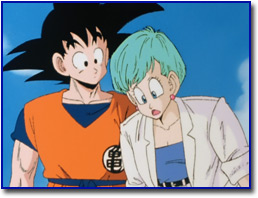 Japanese Blu-Ray
Japanese Blu-Ray |
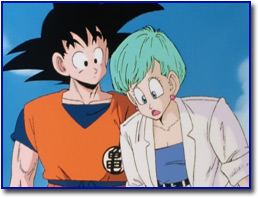 North American DVD
North American DVD |
This is, of course, all opposed to the Japanese R2 DVD releases, which are cropped to 16:9, feature additional saturation, and suffer from poor encodes. For one of the first times, a North American DVD release of a DragonBall production is vastly superior to its Japanese counterpart!
In some ways, it may almost be better to watch the series in standard definition (minus some originally-high-defintion scenes such as the new opening and closing themes) on an old CRT. The type of film used for a weekly series like DragonBall Z was never intended to be viewed with this fidelity, and even a clean remastering process like Kai brings out the worst in it from time to time.
It should be noted that while the Blu-ray set contains 9 episodes on the first disc and 4 on the second disc (along with the trailers and extras), the DVD set contains 7 episodes on the first disc and 6 on the second, spacing everything out a little more appropriately.
On the audio side of things, everyone wins. The North American Blu-ray brings a lossless, Dolby TrueHD stereo track for the Japanese language side (originally PCM on the Japanese Blu-ray), while adding a similar 5.1 surround track for their English dub. It is a shame that the Japanese do not appear to have produced a surround track for the original version, but with an older show being the true underlying footage, it is not a huge necessity. Both tracks sound fantastic, bright, and loud. Music and voices boom when appropriate with crystal-clear attention to detail. It is something we as fans of the original Japanese version have never been used to, and only slightly experienced with the fantastic audio remastering on "Dragon Box: The Movies".
On the North American DVD, the original Japanese stereo track is presented in 192 kbps, while the English dub retains its 5.1 track at 448 kbps — all fairly standard, expected, and serviceable.
One of the most confusing changes leading up to the product's release was the slight name change from its original DragonBall Kai in Japan to DragonBall Z Kai for its North American release. This appears to have been a request from Toei, so we will let FUNimation off the hook for that one. It is a pretty minor change, and one that perhaps works out best for FUNimation in the long run (allowing them to keep that recognizable and most-profitable "Z" moniker). This does mean that all title cards and eyecatches have the revised "Z Kai" logo, even when viewing the series in Japanese. Sadly, this is also reflected in the translations when viewing in Japanese, subtitling the dialogue as "DragonBall Z Kai" when clearly spoken as just "DragonBall Kai". It is a minor issue, and one that hardly affects any enjoyment of the show, but an issue none-the-less.
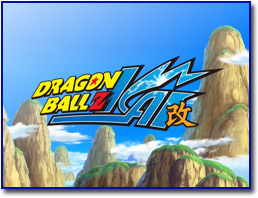 New "Z Kai" Logo
New "Z Kai" Logo |
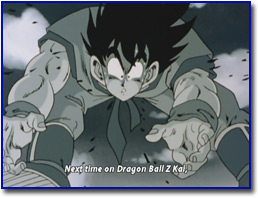 "Z Kai" in the Japanese-language subtitles
"Z Kai" in the Japanese-language subtitles |
Interestingly, the first episode of FUNimation's release retains the original Japanese version of the logo, as does the "clean opening" in the "Extras".
All eyecatches and "Next Episode Previews" are included, unlike prior franchise releases (which may have had just one or neither of the above). On the English dub side of the audio, the preview's narration is presented by an in-character Goku (and occasionally other characters), mirroring the Japanese side.
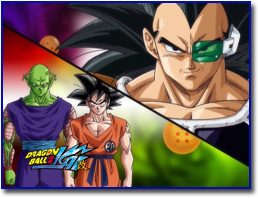 Eyecatch
Eyecatch |
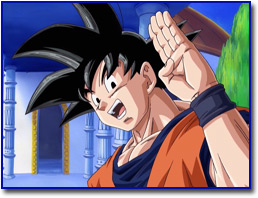 Next Episode Preview
Next Episode Preview |
FUNimation's release exclusively features English-language episode title cards, a standard they have moved toward in recent years. For the most part, episode titles are near-identical to their appropriate translations of the original Japanese. Some changes are expected (dropping all instances of "Son" in "Son Goku"), while others are simply done for no apparent reason.
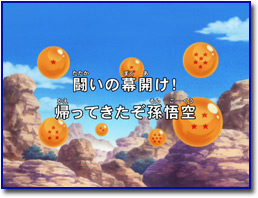 Original Japanese Title Card
Original Japanese Title Card |
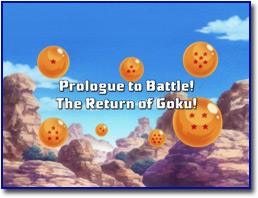 FUNimation English Language Title Card
FUNimation English Language Title Card |
Long-time fan Steve Simmons once again provides the subtitle translations for the Japanese audio track. Simmons does a fantastic job of capturing all of the characters' subtleties in his translation, from the use of "ain't" with Goku, to Chi-Chi's "Goku-sa", to quick explanations in brackets for Kaiô's puns. There is never a concern that you are missing out on what a character is saying or how they intended to say it, and we could not be happier.
One minor aspect missing from the English release (yet present on the Japanese Blu-ray) is the pre-episode announcement card and jingle. It is not a huge loss, and since FUNimation has yet to really acknowledge that Kai was developed for the 20th anniversary of DragonBall Z (since it is significantly "younger" than that for most of their audience, perhaps) we can understand why it was left off. It may be that it was not even included with their materials in the first place.
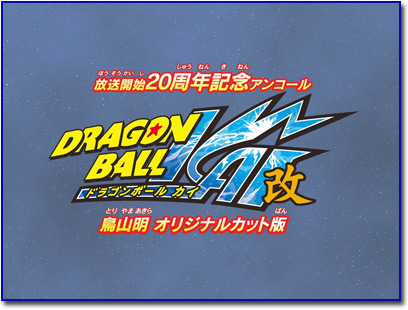
The Blu-ray menus feature fast-paced scenes from the TV episodes with a minimalist option bar across the bottom of the screen while music from Kenji Yamamoto's score plays over top. It is fast, effective, and gets the job done. Over on the DVD side, menus are static images, though new BGM tracks play on each sub-menu.
Overall, the presentation is pretty top-notch. Everything looks and sounds great.
Daizenshuu EX is a website whose goal is to spread information about and enjoyment of (primarily) the original Japanese version of the franchise. It is the sole version that can be (and is) enjoyed worldwide, regardless of one's native language or cultural background. Regular visitors know this well, and based on our research, they appear to be of the same mindset.
On the other hand, we also receive a fair share of audience members who are either just learning about how there is an "original version" of the franchise, or who (for whatever reason they may have) choose to not exclusively follow it. That is fine, and we accept that. Many of these audience members are those living in North America and have been fans of what they have known to be the only version of the series — the English dub produced by FUNimation. When some of these fans read or hear anything ranging from off-hand comments to in-depth discussions that do not put "their" version of the franchise in the most positive light, they start asking questions. Often it is sheer curiosity and wonder that what they have known to be the single version of the series is somehow no longer the center of the universe.
Other times, it reeks of validation-seeking. What do you mean the dub is not good? What do you mean the script is bad? What do you mean the music is bad? What do you mean some voices are miscast? It is a defense maneuver, and one that any fan of anything (anime, sports, video games, television, technology, etc.) is familiar with and has probably participated in. You see it often in any type of review — if the reader has a different opinion, somehow the review is "wrong", regardless of the education and background that the reviewer has, which is often times far more substantial than the reader knows.
That one word — "validation" — is what it all comes back to with the new English dub for Kai. For FUNimation dub fans (occasionally and affectionately referred to as "loyalists" in many of our conversations, depending on the subject matter), it is about showcasing and hopefully proving how their preferred voice cast is actually good. If a fan of the original Japanese version could concede that the Kai dub was "good", that means they were right all along... right?!
Interestingly, the "validation" is going in the complete opposite direction.
What the dub of Kai proves is that FUNimation's original (well, second-run in some cases) dub of DragonBall Z was awful. Do not misunderstand — it was no Robotech in terms of genuine story re-writing, but it was awful, none-the-less. The cast and crew knew it, and have finally begun to express those feeling publicly. The only ones that refused to admit it were the "loyalist" fans that we referred to earlier. I have seen it referred to as a quasi-example of Stockholm syndrome (where the fans have been so horribly indoctrinated with the prior dub that they are unable to step back and take a different look at it), and that may very well be the best way to describe it.
What FUNimation's English dub of Kai proves is that simply producing the show for what it is can create an enjoyable, legitimate, and respectful product. There is no need to "punch up" the script. There is no need to dance around foreign concepts (what few there are in this series). There is no need to change the music. There is no need to shy away from character subtleties.
The English dub needs Kai more than the original Japanese version ever did, because the new English dub gives FUNimation a chance to validate the show as-is for the first time in this country.
We are already this far into analyzing the dub, and have not even directly spoken about it, though! The question remains: is the new dub any good...?
That depends on what kind of fan you are. It is a cop-out answer, but it is a realistic one.
I have zero attachment to FUNimation's standard voice cast for the franchise. They were not the first English cast I heard for the series (and did not even exist until three-to-four years into my fandom). They have not been my primary cast with viewings ever. At this point, we are not even talking about quality of acting — we are simply stating facts. It is a cast I am familiar with, but one I have no attachment to. Sure, I have had plenty of qualms with casting choices and even specific acting styles for some of the characters over the last 11-12 years that this cast has been involved with the show, but I feel that I can listen in on this cast the same way I could with the Mexican cast or Cantonese cast — halfway objectively.
Now, now... the same "loyalists" that have been mentioned from time to time may think that is a delusional statement to make, but just roll with me for a little bit here.
One of the aspects that made the prior dub of the DragonBall Z TV series from FUNimation so grating was the plethora of "punch-up" writing. This could range from excessive dialogue on one end of the spectrum to horrible attempts at jokes that no-one should ever speak aloud on the other side. Classic and played-out examples are the usual ones like "Come to big daddy Garlic!" and "Krillin's in the house!"
For the most part, these no longer exist. Viewing the series in English with the subtitle track for the Japanese version reveals that the vast majority of the dialogue is, if not verbatim, in a very close style with proper intent. The franchise has approached this level at certain points (dub fans often point to the Buu arc of the DragonBall Z dub and much of DragonBall GT's dub), but the fact remains that it never consistently stayed at this level, and ultimately devolved back into a near parody of itself. That is no longer the case, completely validating that the franchise is fine as-is and does not need executives with cigars in their mouths tossing out one-liners as the actors roll their eyes.
That being said, there are some examples that start heading back in the direction of "old" dubbing from FUNimation. In particular, after Piccolo states that he will be taking Gohan to train with him for the next year, the dialogue in the English dub is:
Bulma: "Don't you need a parent's signature for that?"
Kuririn: "Yeah, a form or something..."
It is simply not what is being said in the original script, and as noted, is just a little too close to heading back in the direction of how FUNimation used to adapt the scripts. Perhaps the worst offender is one that immediately brings to mind the fan-favorite parody series DBZ Abridged:
Nappa: I hate the media!
These examples are the ones that invoke facepalms and remind you that, yes, you are indeed watching an English dub of DragonBall Z from FUNimation.
Interestingly, it seems as if FUNimation's original 1996 dub included an allusion to drinking that has been swept away in this supposedly "more accurate" script. Complete with classic over-acting courtesy of Terry Klassen, the line from Kuririn (directed toward Raditz), "I... think somebody's been dipping into the eggnog. Allow me to show you off the island!" has been tossed aside in favor of more generic dialogue.
An example of a larger string of dialogue being completely ignored and written around is Kami-sama's explanation about those killed by the Mazoku ("Demon Clan") and how they typically do not pass along to the afterlife in normal fashion. In this new dub, the dialogue is completely rewritten and focuses on the changes going on within Piccolo, almost repeating itself back around again for lack of anything else to talk about (since the original script is being ignored) and there is still so much time to fill.
There is also the occasional example of characters spouting out additional dialogue off-screen (such as Piccolo as he is about to blast Raditz during their first encounter). In the beginning exposition for the very first episode, the narrator describes Goku and Chi-Chi as "childhood sweethearts", which simply does not describe their relationship at all. Thankfully, these examples are few and far between, and for the most part do not negatively affect or drag down what is otherwise the most faithfully-adapted English script that DragonBall Z has ever received... save for maybe the original versions of the first three DragonBall Z movies produced by FUNimation in conjunction with Pioneer back in 1997-1998.
Related to the script is an aspect that no-one would have seen coming from FUNimation and their dub of DragonBall Z: correct attack names.
Well... for the most part.
My personal standpoint is that any proper noun should retain its original Japanese pronunciation, even in an English dub. Obviously, untranslatable words or phrases (such as "Kamehameha", which [contrary to popular fan belief] does not directly mean or infer a full thought or phrase in particular) should remain in their original, proper-noun form, but even words or phrases that could be "translated" should not be when they are proper nouns.
My train of thought is incredibly over-done, but since the rest of our reviews here on the site are over-done, I may as well toss it all out there. We do not call Son Goku, "Decedent, Aware of Insubstantiality" (which would be a translation of his name, all stemming from a semi-convoluted naming scheme for Sun Wukong in Journey to the West). For decades, video game players have had no qualms with the words "Hadoken" and "Shoryuken" (though admittedly tossing out the generic "fireball" and "dragon punch" monikers at times). Today's Naruto fans, even those of an English version, do not appear to have too much of a problem with phrases such as "Kage Bunshin no Jutsu" and "Rasengan".
(Then again, maybe they do, and because I am not deeply ingrained in those fandoms, I am way off the mark. Feel free to correct me and show me examples to the contrary.)
Thus, any proper nouns should retain their original, (in this case) Japanese pronunciation.
Right off the bat, we are blown away with a dubbed Piccolo shouting aloud Makankô-sappô (or roughly "Demonic Death-Cannon of Penetrating Light"), previously renamed to "Special Beam Cannon" in FUNimation's English dub ever since 1996.
This was the correct route for FUNimation to take. Unfortunately, it does not (and will continue not to) extend to all attacks throughout the series. The Genki-Dama retains its (semi-accurate) "Spirit Bomb" English name adaptation, while attacks like the Kikô-hô ("Ki/Spirit Cultivation Cannon") retain their vastly-changed names (in this case, "Tri-Beam"). Pronunciation issues also plague some of the changes. While Kaiô-Ken has thankfully been corrected from its incorrect "Kayo-Ken" pronunciation (the "Kai" in Kaiô-Ken being the same as in Kaiô-sama or "King Kai", always making it an inexcusable error), Kuririn's Kienzan ends up with a mispronunciation as "Kienzen". Examples like this are simple quality-check issues, and are unfortunate to hear crop up.
While no exact reason has been given for the inconsistent attack naming schemes, the most popular and logical theory explains that attacks which are introduced in the first DragonBall series or subsequently used in the DragonBall GT TV series will keep their changed/adapted names from those prior FUNimation English dubs for consistency purposes. While this, in theory, makes sense... it also goes against everything FUNimation appears to be shooting for with their dub of Kai, which is distancing themselves from their prior "reversioning" ways and finally remaining faithful to the source material. You are already breaking consistency with so many other items, so why not go all the way?
The NickToons television broadcast had an interesting reveal of 天下一武道会 being painted over as "Tenkaichi Budoukai" (visually breaking consistency with their typical "World Martial Arts Tournament" name), meaning there does not actually appear to be any real consistency with or to a style guide... so why carry over prior "reversionings" at all...? Why must there be an English dub that mixes "Tien Shinhan" with "Masenko" with the old (and incorrect) "Seiyan" pronunciation" alongside "Makankô-sappô"...? I cannot imagine that this collection of phrases and names appeals to any non-apathetic fan.
Furthermore, with the TV broadcast reverting back to prior consistency with phrases like "Special Beam Cannon", what is preventing them from separating the TV broadcast and home release versions even further? Go all-out on the home release with everything being correct, and appease the mass-market audience with the TV broadcast (hopefully suckering them into supporting the home release and having their mind blown at a vastly superior product). FUNimation already has precedent in this regard with "Zoro" versus "Zolo" in One Piece, so apply these new standards to DragonBall Z for a change!
With a proper and (mostly) faithful script in place, we turn things over to the music.
When you look back at the post-Barry Watson recent years, it is apparent that FUNimation has been slowly weaning the franchise toward this kind of treatment. We spoke about this extensively in our giant feature prior to the domestic Dragon Box releases, where the original DragonBall TV series always used the original Japanese musical score, a dub with the Japanese musical score was included on the orange bricks for DragonBall Z, and a similar dub with the Japanese musical score was included on the green bricks for DragonBall GT. When the domestic Dragon Box sets were released exclusively with a dub that contained the original Japanese score (in addition to the actual, original Japanese language track, of course), it was clear that FUNimation was shrugging off any involvement with score replacements for the future.
Needless to say, FUNimation's English dub of Kai retains Kenji Yamamoto's musical score, and that is all there is to it. No further conversation or discussion is necessary. We are back to the "state of being" that I often describe — it is what it is.
With a proper and faithful script in place, and with the musical score untouched, we are left with only one final aspect of the English dub to examine: the voices.
Something that has constantly held back FUNimation's dub of the franchise was the fact that so many main-character voices were cast based on the actor's ability to mimic the prior (Ocean Studios) voice cast used in the first two "seasons" of DragonBall Z's dub. While you could argue that many of these actors and actresses have been able to break those old ties and take the character in its own direction (Sonny Strait's Kuririn, for example)... others have not been so fortunate.
The most painful examples of this are characters like Kaiô-sama and Gyû-Maô (Ox Demon King). While not quite at the unintelligible level of characters like Recoom in FUNimation's re-dub of the Freeza arc episodes, they are simply painful to listen to. Exaggerated and "doofus" voices fit well in exaggerated shows with doofus characters (such as FUNimation's own adaptation of Crayon Shin-chan). Unfortunately for these actors and their performances, this area of the DragonBall story is not one of those shows.
In the case of Kaiô, they miss the entire point of the character. While, yes, he is a a joke-spewing, blue, cat-fish-looking creature, he is also a god. What makes Jôji Yanami's performance of the character so beautiful is his ability to play the genuinely-respected, honorable deity of stature that he is. While Sean Schemmel's diction and acting ability in-character as Kaiô has drastically improved over the years, we miss an entire aspect of the character since he constantly sounds as if he has marbles in mouth. It is impossible to ever take him seriously, which undermines the character himself. It is an unfortunate holdover due to casting in the late 1990s being based on mimicking a prior cast. If main characters like Gohan are able to receive a recast voice actor/actress, a character like Kaiô (who is probably one with a similar amount of screen time as the re-cast Bulma in the grand scheme of things) almost certainly should have been recast.
Characters in FUNimation's dub such as Dabra, #17, and #18 were not subject to mimicking prior voices, and were therefore able to be cast appropriately and bust out appropriate and faithful performances. These future Kai roles will probably be the most believable and engaging of them all.
We already know that further cast replacements will occur later in the Freeza story arc of the series, so it remains to be seen how many of these character representations can be corrected to the same level as the rest of the show is receiving. Kaiô was in drastic need of this, but Freeza himself (along with many of his minions, including those of Ginyu-Tokusentai) are right up there, if not higher. Regardless of an actor's ability and their desire to put in an effort above and beyond the call of duty, when the performance style itself is not appropriate for the type of character, there should be no hesitancy to correct that when it seems as if the entire point of the product is to move in that direction.
On the subject of voice replacements (and to bring things back around to this specific product, being the first thirteen episodes of the series), notable replacements include Colleen Clinkenbeard as Gohan, Monica Rial as Bulma, and Doc Morgan as the narrator.
The narrator is perhaps the easiest to address, having the least amount of lines, and being "replaced" more often than any other "voice" in the franchise. From the original Ocean Group narrator of Doc Harris, to the fired/let-go/otherwise-removed, over-the-top Dale Kelly, to the final Z replacement of Kyle Hebert, the narrator was a voice that never stayed the same (extending to Brice Armstrong in DragonBall and Andrew Chandler in DragonBall GT). Kai picks up with the same narrator rotation, bringing in newcomer Doc Morgan. While not quite as "old-timer" as I would have hoped, there is a kindness and authority to the voice that has not been present since that original narration by Doc Harris so many years prior. The one aspect that holds back the narrator and unfortunately recalls the awful Dale Kelly interpretation is how every single episode must end with a variation on "Find out on the next episode of DragonBall Z Kai!" This type of dialogue is normally reserved for Goku in the next-episode preview — where it is and belongs — and unfortunately creates an annoying redundancy. Furthermore, since the narrator is tossing that out there in addition to all of his standard exposition for the end of the episode, everything feels rushed, sped through, and therefore comical.
Monica Rial's Bulma seems like another (unintentional?) nod to the first Ocean Group cast. It seems at odds to be decrying mimicry of that cast while at the same time complimenting comparisons, but that is exactly what I am doing. Rial's Bulma gives the same warmth and intelligence that Lalaina Lindbjerg first brought to the table, which was missing from the always-bratty performance from Tiffany Vollmer. It is a natural voice performance, which is always going to work better than "doing a character voice". We will spend much more time with Rial's interpretation of the character in the following story arc, but she appears to have laid a decent groundwork for the future.
Much like Sean Schemmel's garbled performance of Kaiô, the unnatural rasp of Stephanie Nadolny's Gohan (as well as a young Goku) was always somewhat grating and got in the way of simply acting with the voice. Colleen Clinkenbeard appears to nail the obnoxious, whiny side of the very young Gohan. Even the endearing moments are once again genuinely endearing now that a believable voice is cast in the role, such as Gohan's naive and innocent comment about Piccolo not actually being the enemy. Gohan is another character where we are just only being introduced to the voice, and he will receive a lot more attention as the series goes on. Will Clinkenbeard be able to act with the same believable tone throughout all of Gohan's younger ages and physical appearances? Or will the performance be subject to the same unnatural evolutions as prior English castings? Only time will tell, but it is finally an English voice for the character that I am curious about checking in with every so often.
Returning actors and voices run the gamut as always with FUNimation's dubbing of the franchise. Christopher Sabat's Piccolo has shifted more and more toward his natural speaking voice over the years, and while loud yells still sound somewhat forced, is it leagues above and beyond how the character was originally played in 1999. At the same time, Sabat's Vegeta (who admittedly does not get a huge amount of screen time just yet in the series), as our buddy Hujio describes him, just sounds like a dude in a booth doing a gruff voice. Regardless of Sabat's improved ability to act while in that voice, it is forced and completely unbelievable. For a character that will remain a core aspect of the entire series, it is a shame.
Sean Schemmel's Goku is an interesting character. Like Gohan, we mostly get just an early and one-sided version of the character in these first batch of episodes — in the case of Goku, it is the happy, nonchalant, everyday version. I have gone on record before as saying that Schemmel captures this Goku incredibly well, and when given the right script, even I am happy to admit that it finally approaches being the "Goku" that I know. At the same time, I have never completely bought the "angry" and fighting version of Schemmel's Goku, again equating it to just a guy doing a voice (at least in this case giving us half the character, rather than none at all as with Sabat and his Vegeta). What Goku truly needs is just that extra push into "hick" territory. We will never hear Goku talking like a southern bit of white trash (nor is that an equivalent of Nozawa's ad-libbing for the character either, but noted as a point of reference)... but at the same time, tossing in an "ain't" or droppin' a "g" every so often would go a long way. Steve Simmons' subtitle translations do this incredibly well, and seem as if they would work perfectly for an English-language performance without compromising the established tone of Schemmel's Goku. There were a couple cases in this new dub where that actually happened (such as a shout of "Yo!" up to Enma), and it was as if Nozawa momentarily channeled herself into English. Give us more, and I might start believing the role. I am still hesitant about where Schemmel will take Goku — I (in theory) like how he adapted the voice for SSJ3 (and ultimately SSJ4), but will he competently handle the in-between stages of the character in this new dub, an area where his first time through he was a complete novice? Perhaps that alone may be his strongest motivation. There is a long way to go with Goku, and this is one character the viewer will hear more than anyone else.
Other returning character voices are par-for-the-course, in all their negative and positive ways. Sonny Strait has made Kuririn his own more than any other character and any other actor in FUNimation's pool. John Burgmeier's Tenshinhan is far too "light" sounding (does that even make sense?!) and nasally-"tough guy", and combined with an adapted script (including "Tri-Beam"), is a constant reminder that you are in fact still watching a semi-traditional English dub of DragonBall Z. Kyle Hebert's Gyû-Maô, as mentioned earlier, may be the right voice range for the character, but is played up and exaggerated to the point of absurdity. Phil Parson's Nappa is an adequate performance with believable lines ("That's more like it, boy!"), but ultimately suffers from a bout of over-writing. By and large, any returning cast member plays their role the same as they have in recent years via products like video games, but with a script far superior to the original dub bringing out whatever the best in them happens to be.
One final aspect of the new English dub is that the opening and closing themes are performed in English. While this was a standard practice in the 1990s for English dubs (see Tenchi Muyo! and even the Ranma 1/2 OVAs as prime examples), this practice faded into obscurity for a while. FUNimation has brought it back around as a standard, as seen with their dub of the first DragonBall TV series, and even going so far as to create new dubs of the opening and closing themes for the DragonBall GT TV series on its most recent "remastered" DVD release (and yet keeping all theme songs in Japanese for certain series like Fullmetal Alchemist, even with its TV broadcast).
The opening theme, "Dragon Soul", is performed by Sean Schemmel (Goku, Kaiô) for the English audio track. It matches the original Japanese performance by Takayoshi Tanimoto in that some sort of enthusiasm is missing. Additionally, certain points seem slightly off-timed, such as the "Don't stop, don't stop..." replacement for "Dokkan, dokkan..." coming into the chorus. It just feels sloppy at certain points in the song. Some fans have complained about an overuse of auto-tune in the performance, but this (again) mirrors the original Japanese version, and does not feel out of place. I will note that I have an easier time understanding the lyrics in Japanese than I do in English... and as a native English speaker, this is somewhat embarrassing for the performance. Overall it is entirely adequate, but (much like the general script for the show) could have been hit out of the ballpark with a couple more refinements.
Interestingly, an alternate and TV-sized English version of the opening theme was recorded by Vic Mignogna (Broli) for the American TV broadcast of the series. While it retains most of the same lyrics, the performance is slightly different. Since this version is not present on the home release, it does not factor in to its assessment.
The closing theme, "Yeah! Break! Care! Break!", is a different monster entirely. Whereas I could at least understand the majority of the lyrics in the English version of the opening, the English version of this song is near-incomprehensible. It lacks any feeling what-so-ever, and is completely forgettable.
We finally come around to the biggest question of them all: which audience is this dub for? It is far more accurate than ever before, which alienates whatever audience the heavily-"reversioned"... err... "version"... previously had. It is not entirely accurate and contains some odd voice castings, which may alienate fans of exceptional dubs. It is certainly not accurate enough (with the odd voice castings, occasional script re-writes, and mix-matched attack names) to completely satisfy fans of the original Japanese version.
FUNimation clearly shot for as wide a range as they could with this dub, but did so in a way that finally (at least partially) respects both the franchise and their audience at the same time. For DragonBall Z, this is a first, and it demands applause.
Personally, based on everything that was stated and hyped ahead of time, we were hoping for a little more. They came incredibly close, but ultimately let us down just a little too much. At the same time, an English dub of the series is not something we were ever going to have more than a passing curiosity with, anyway. This dub was not for us, but the fact that it was not only watchable, but at times halfway enjoyable really speaks volumes about how far they have come. For what feels like the first time ever with this franchise, I will probably have that occasional desire to switch over to the English side just to see how something was handled and how the character performances have evolved... and no longer in a car-crash sort of way.
At the same time, there will be those occasional cringes brought forth by incorrect names, attacks, and minor script changes. It seems that even the FUNimation of today cannot completely move past this with their treatment of DragonBall.
FUNimation's Blu-ray release of DragonBall Z Kai is much more in line with any other current release than their premium and "remastered" versions of other DragonBall series. Going along with the norm, "Part One" is a 13-episode release that spans two discs housed in a single, thin-pack case.
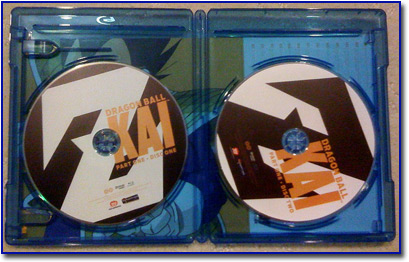
The plastic case has a cardboard slipcover (seen at the very beginning of this review). The minimalist cover art is different from the original Japanese release, but works well for what it is. Thankfully, the "Season One" aspect from the original retailer listings has been removed; the product is now simply just "Part One".
The back of the cardboard slipcover is a nice arrangement that uses an image of Goku on the right side, a series of five smaller screen shots near the bottom, and appropriate splashes of text. It clearly notes the inclusion of 13 episodes, both the English and Japanese audio tracks (as well as the corresponding subtitles), and all other relevant information.
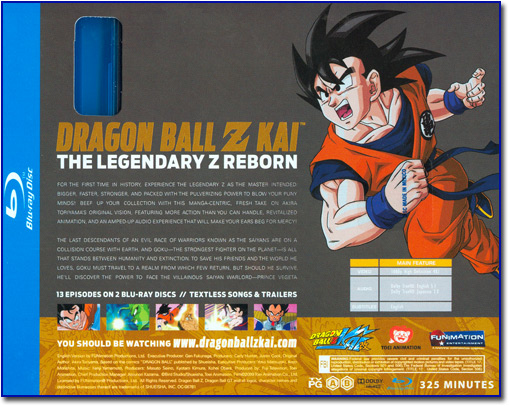
The actual plastic case inside the slipcover has the exact same front and back art as what covers it. On its opposite side, however, is a bright picture of Vegeta in his armor with a scouter opposite a white background with incredibly small orange text with the thirteen episode numbers and titles.
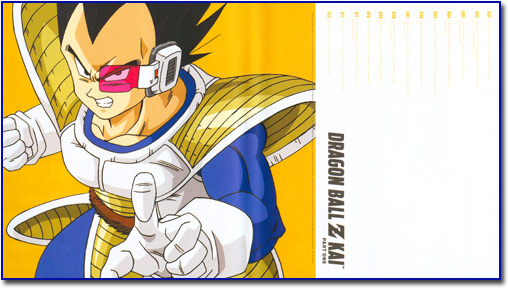
The packaging is simple, efficient for brick-and-mortar sale, and gets the job done. We have no real complaints.
Similar to the first Japanese Blu-ray box set (as opposed to the single-disc, "Volume One" Blu-ray release in Japan), the North American set contains creditless versions of the opening and closing themes. Interestingly, the opening retains its original Japanese DragonBall Kai (sans-"Z") logo, which also includes the Japanese writing within the logo, as well.
The set also contains the standard trailers for other FUNimation properties.
While FUNimation's Dragon Box sets are currently receiving a great translation of the "Dragonbook" extras from the original Japanese sets, there is currently no word on whether any of the special books that come included with the Japanese Kai box sets will make their way to America. Their Dragon Box releases are clearly a "premium" product, and while Kai is getting significant attention and a fantastic treatment across the board, it is still a cheaper, more-"mainstream" type of product. This keeps the cost down, so it is to be expected.
Are you willing to watch the first batch of DragonBall Z episodes again? Despite being a "new" product, Kai truly is nothing more than a derivative version of Z, and this portion of the series has received four releases in North America prior to this. It is a very strong portion of the series, though (especially with the removal of some of the weaker filler material, and even at the expense of some of the great filler material). No matter which way you shake it, this is a great batch of episodes.
One problem for the general consumer is that it is competing for mind share and money with the fantastic Dragon Box version of these episodes; even the three-year-old, incredibly-flawed orange brick version is still available, and a steal at around $20 on sites like Amazon.
Kai is simultaneously for the "casual" and "hardcore" fans. FUNimation shot for a huge encompassment of fans, and at the expense of very few types. Finally going on record as saying that their prior dub was at times rushed, "dumbed-down", and featured replacement music that greatly affected the integrity of the show, it validates everything that old-school fans of the original Japanese version have been saying about FUNimation's dub for (more than!) the last decade. In fact, it can be almost creepy hearing our own thoughts regurgitated back at us in an official capacity like that.
Are their official statements to be trusted, though, or at least held in high regard? Certain hold-overs from previous "reversionings" rear their ugly heads on occasion. This prevents the new English dub from being everything it could (and was promised) to be. The new English dub makes a great first impression, but starts to reveal its flaws upon repeated viewings — inconsistent naming schemes for attacks and characters, script changes, miscast character voice hold-overs, etc. At the same time, the original Japanese version is right there from the start, so it is no sweat off our fandom's collective backs.
At the end of the day, this first volume of Kai from FUNimation is incredibly solid. There are a couple things weighing it down, but with those things almost exclusively being on the English dub side of things, it will hardly affect our (and our general audience's) regular viewing of the show. For us, it is a question of whether or not we miss the extended scenes and filler episodes, and most significantly, Shunsuke Kikuchi's iconic musical score.
If you have been holding out for the domestic release of Kai, go ahead and grab it (especially since most retailers are offering it for significantly less than its MSRP) — it is probably 90% of the way toward everything you hoped it would be. Just don't forget about those Dragon Box sets, too...!
Dragon Ball Z Kai - Part One is available at the following online retailers:
|